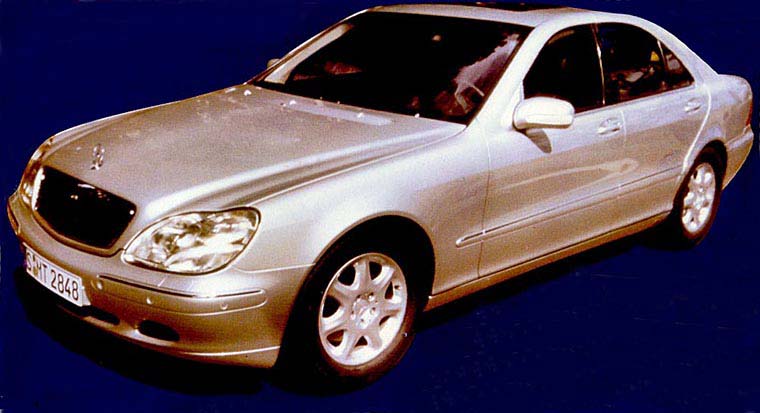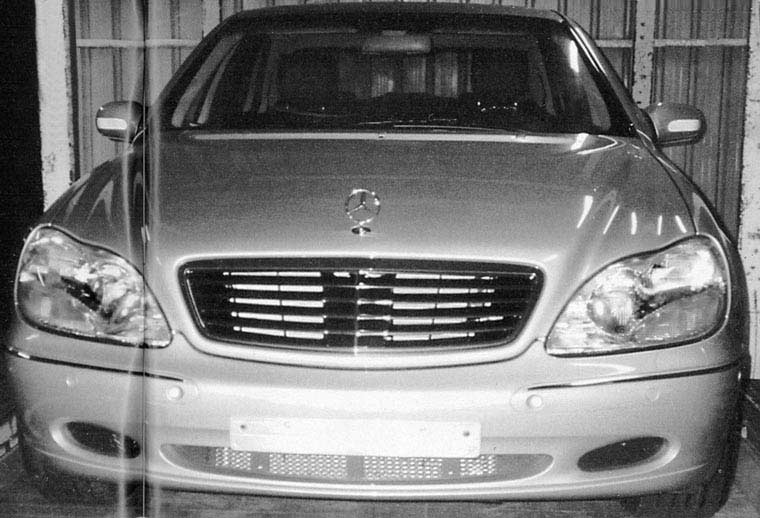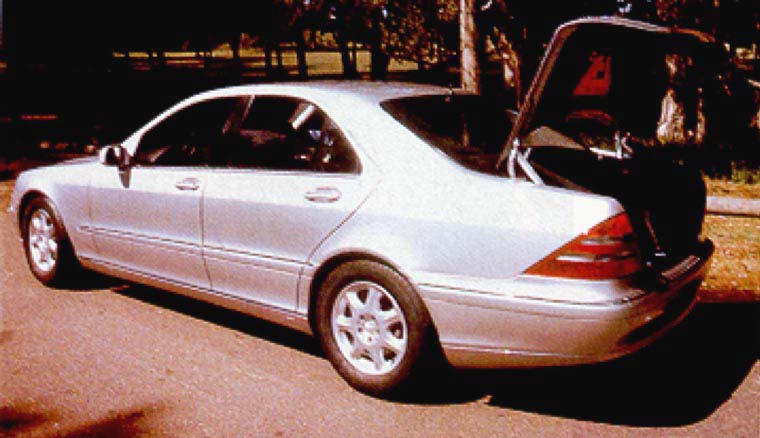
 |
| Photo: AutoCar Additional background retouching by MBEP webmaster |
Article from "AUTOCAR" about the new S-Class W220
Mercedes-Benz is set to re-establish itself as maker of
the world's best luxury car with the launch of its
new S-Class this autumn. Pictured here for the first
time without any disguise during a photo shoot in
Australia, the fifth-generation S-Class departs radically
from the nine-year-old model it replaces with
sleek new styling, reduced dimensions and an extended
range of petrol and common rail diesel engines,
among a raft of high-tech innovations aimed at seeing
off the BMW 7-Series and its other big luxury car rivals.
Codenamed W220, the new Mercedes flagship is charged
with the task of restoring the German car maker's long-held image for world-beating
engineering in in the wake of last year's A-Class
rollover debacle, production delays with the new Smart city car and
recent recalls with the heavily touted Brake Assist system on the CLK.
The new S-Class is expected to make its world premiere
at the Paris Motor Show in September, with the first deliveries of right-hand-drive
cars due in mid to late November. Despite improved equipment levels right
across the range, prices are not expected to rise by more than five per
cent, suggesting a range from British Pounds 44.000 to British Pounds 107.000.
You won't have to look too far to recognize the new S-Class.
Clothed in a new body that has been cleverly designed to hide its bulk,
the new car immediately looks a lot sleeker, tauter and more muscular than
its predecessor. Big Xenon-charged headlamps, a heavily raked chrome grille,
steeper screen angles, flowing C-pillars and exterior mirrors that house
indicator repeater units are just some of the highlights distinguishing
new from old. The new car is said to boast a drag coefficient of just 0.26
in skinny-tyre form.
 |
| Photo and photo text: AutoBild Additional background retouching by MBEP webmaster |
Acting on criticism that the current S-Class is too big
for the world's more congested cities, its designers have shaved almost
120mm from its overall length, bringing it down under the politically sensitive
five-metre mark at 4990mm in short wheelbase guise. Width and height have
also been reduced by 40mm and 31mm respectively. Despite these dimensional
changes, the new car retains the same 3040mm wheelbase in a bid to provide
it with class-leading levels of cabin space. As a result, the new model
boasts much-reduced overhangs front and rear.
Along with the slimmed-down exterior, the new S-Class
has also shed as much as 300kg compared with today's models - a remarkable
achievement given the safety requirements it now has to meet. Stuttgart
engineers credit the reduced weight to the use of a high percentage of
aluminium, magnesium and light weight steel. Another reason is that the
number of components used to build the car has been reduced - achieved
through a closer relationship with key suppliers, many of whom were brought
in at the very outset of the new S-Class`s 38-month development cycle.
Another factor that has helped Mercedes fight S-Class
flab is the adoption of a new range of all-aluminium V6 and V8 petrol engines,
each featuring Mercedes' unusual twin-spark ignition and
three-valve per cylinder head arrangement for reduced
emissions and class-leading fuel economy.
The new 90deg units replace the old in-line six and four-valve
V8 powerplants, both of which have been pensioned off because they are
unable to pass tough new EC emission standards.
 |
| Photo: AutoCar |
 |
| Photo: AutoCar Additional background retouching by MBEP webmaster |
 |
| Photo and photo text: AutoBild |
Helping the new S-Class to improve on its already impressive
refinement levels is a new weight-optimised bodyshell designed using the
latest in computer-aided design and manufacturing
technology. Fashioned partly from a new lightweight steel,
it is rumoured to be up to 40 per cent stiffer than that of the current
model in certain areas, particularly bending, reducing vibrations at associated
noise levels. The stiffer body also plays a crucial role in ensuring that
the S-Class retains its reputation as one of the world's safest cars, providing
an improved safety cell for its occupants and larger crumple zones.
Improved cabin architecture has allowed Mercedes to increase
the amount of space in the new S-Class, despite the reduction in its external
dimensions. The use of virtual reality imaging during the design phase
has also led to some important ergonomic changes, including the relocation
of the electric window switches from their traditional place down on the
transmission tunnel up on to the door rests, along with the electric seat
switches. In a move that will bring a smile to the BMW faces, Mercedes
will also offer the new S-Class with a new multi-function steering wheel
in the same vein as that of the 7-Series.
As with each generation of the S-Class, Mercedes has
striven to deliver the very last word in safety.
And that looks to be the case again. The W220 will be
one of the first cars to offer Autoliv`s new head curtain airbag. This
new system is expected to complement standard twin face and front door
airbags in all models, protecting occupants`s heads from the side glass
in a heavy side impact. Added to this will be optional rear door airbags.
The S-Class has never been a car to want for luxury,
so it comes as no surprise that top-line versions will be offered with
just about every piece of equipment you could imagine. Forget everyday
items such as electric windows and central locking; the new S-Class aims
much higher, with everything from pollen-reducing filters to individual
climate control air conditioning and the latest in satellite navigation
and GSM telephones.
There's even talk of the W220 adopting a speech recognition
system for all major dashboard controls,
which means the driver's hand will never need to leave
the wheel. And if you want to access e-mail on the run into work, no problem:
Mercedes is working on that for the new S-Class, too.
End of article from "Autocar".
Thanks to Colin from the UK for sending the article and
the photos!
Below follows a translated article
from Auto Motor und Sport
 |
| Photo and photo text: AutoBild |
Heavily Lightened
Translation of an article from "Auto Motor und Sport" 1997 written by Bernd Stegemann.
Mercedes slims: The heavyweight of the German luxury cars from autumn 1998 will be lighter, slimmer and more economical but more luxurious again. ...
If little strokes fell big oaks then on the actual S-Class
W140 a heavy series of strokes must have gone down. When the monument of
German art of engineering came onto the market in March 1991 malice came
from all sides. Flaws at manufacturing and payload left scratches in the
paint as well as the harsh critics on fuel consumption, size and appearance
of the car. In America and Asia the flagship is being appreciated
even because of its representative appearance. After now 350.000 sold cars
the successor makes his debut in autumn 1998 and shall end this colossal
chapter. With the new one - internal designation W220 - inner size hides
under a flowing, optically restraining shell which nearly looks not more
bulky than the smaller E-Class.
With 4,99 metres the normal sedan ((short wheelbase))
after all is 12 centimetres shorter than the up to now model and width
(1,85 metres) and height (1,45 metres) each is shortened roughly 3 centimetres.
Because the wheelbase (3,04 metres) remains unchanged
in the inside no losses worth mentioning have
to be feared. The comfort dimensions (distance between
acceleration pedal and back seat rest) even increases slightly and the
more limited head- and shoulder-space should change nothing on the fact,
that with the space offered Mercedes for the future sets the standard in
the upper class. The trunk, too, will offer at least the familiar volume
(525 litres).
 |
| Graphics: Auto Motor und Sport Translation and additional background retouching by MBEP webmaster |
For an article about the V8 400CDI engine with technical data and a photo click here
For more articles about the
new S-Class click here (e.g. interior photos, older spy-photos)
Last revised technically: Oct. 25th '99 Visits
since Dec. 18th '97  .... .... |
[Sign
Guestbook]
[View Guestbook] |